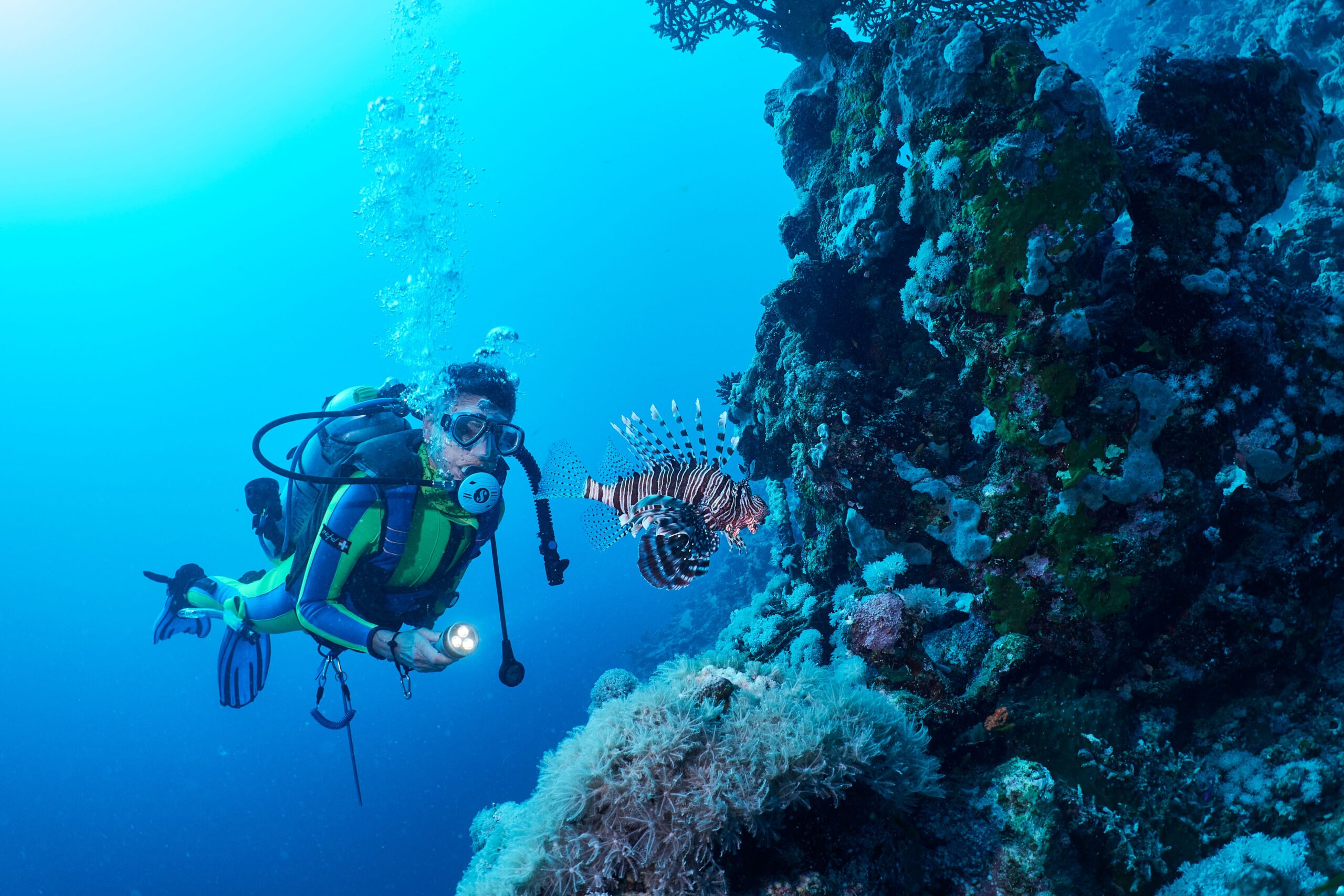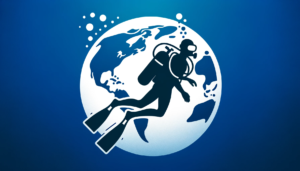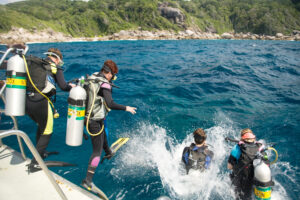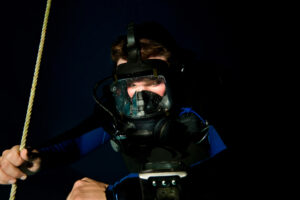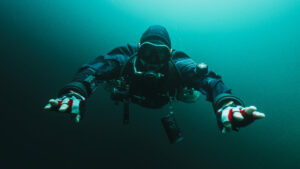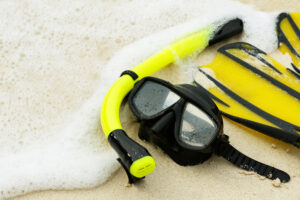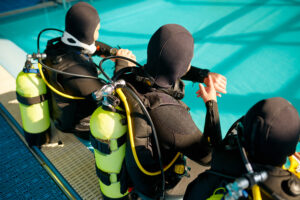What is scuba diving?
Scuba diving is the recreational and professional activity of swimming underwater using self-contained underwater breathing apparatus (SCUBA) equipment. This allows divers to explore the underwater world, venturing into depths and environments that are inaccessible to humans without specialized equipment. The sport has grown in popularity since its inception in the mid-20th century, with millions of people around the world participating in this adventurous and exhilarating activity.
History
The concept of scuba diving can be traced back to ancient civilizations, where people used hollow reeds or animal bladders to breathe underwater for short periods of time. The first recorded use of an underwater breathing device was by the Greek philosopher Aristotle in the 4th century BC. However, modern scuba diving as we know it today began with the invention of the “aqualung” by French naval officer and explorer Jacques-Yves Cousteau and engineer Emile Gagnan in 1943. This innovative device provided divers with a portable, self-contained source of compressed air, revolutionizing underwater exploration and paving the way for modern scuba diving.
Equipment
Scuba diving requires specialized equipment that enables divers to breathe, move, and communicate underwater. Some of the essential components include:
Scuba Tank
A cylinder containing compressed air or other breathing gas mixtures, such as Nitrox or Trimix, which provide the diver with a breathable gas supply.
Regulator
A device that connects to the scuba tank and reduces the high-pressure gas to a breathable pressure, allowing the diver to inhale and exhale comfortably.
Buoyancy Control Device (BCD)
A vest-like piece of equipment that helps the diver control their buoyancy underwater. The BCD can be inflated or deflated, enabling the diver to ascend, descend, or maintain neutral buoyancy.
Dive Mask
A protective covering for the eyes and nose allows the diver to see clearly underwater.
Snorkel
A tube that enables the diver to breathe at the surface without wasting the air supply in their scuba tank.
Fins
Worn on the feet, fins provide divers with the ability to propel themselves underwater with ease.
Dive Computer
A device that calculates and displays important dive information, such as depth, dive time, and no-decompression limits, helping divers manage their dives safely.
Wetsuit or Drysuit
Protective clothing that insulates the diver’s body from the cold water, maintaining body temperature and preventing hypothermia.
Accessories
Additional equipment such as dive lights, underwater cameras, and dive knives may be used to enhance the diving experience and ensure safety.
Training and Certification
Scuba diving is an activity that requires proper training and certification to ensure safety for both the individual diver and the environment. There are several scuba diving certification agencies worldwide, including the Professional Association of Diving Instructors (PADI), Scuba Schools International (SSI), and the National Association of Underwater Instructors (NAUI). These organizations offer various certification courses that cover essential diving skills, safety procedures, and environmental awareness.
Dive Sites and Environments
Scuba divers can explore a wide variety of underwater environments, from warm, tropical coral reefs teeming with marine life to cold, dark shipwrecks steeped in history. Some popular dive destinations include the Great Barrier Reef in Australia, the Red Sea in Egypt, the Caribbean, the Maldives, and the Galápagos Islands. Divers can encounter various marine life, including fish, coral, sharks, rays, turtles, and other fascinating creatures.
Scuba diving also allows divers to explore different types of underwater environments, such as caves, wrecks, and ice diving. Cave diving involves navigating through underwater cave systems, which can be both challenging and rewarding. Wreck diving focuses on exploring sunken ships, aircraft, and other submerged structures, often rich in history and marine life. Ice diving, on the other hand, requires specialized training and equipment to dive safely beneath the ice in freezing conditions.
Safety and Environmental Considerations
Safety is a primary concern in scuba diving, as the underwater environment presents potential hazards to divers. Proper training, equipment maintenance, and adherence to safe diving practices can help minimize risks. Some common safety measures include never diving alone (the “buddy system”), monitoring air consumption, and following decompression guidelines to avoid decompression sickness.
Scuba divers must also be aware of their impact on the environment. The fragile ecosystems, particularly coral reefs, can be easily damaged by careless divers. Practicing good buoyancy control, avoiding contact with marine life, and not disturbing or removing any organisms or artifacts from dive sites are essential practices for responsible divers.
Marine Conservation and Citizen Science
Scuba diving offers unique opportunities for divers to contribute to marine conservation efforts and participate in citizen science initiatives. By collecting data on marine life, water quality, or other relevant factors, divers can contribute to research projects and help monitor the health of underwater ecosystems. Organizations such as Reef Check, Project AWARE, and CoralWatch engage divers worldwide in these efforts, fostering environmental stewardship and promoting awareness of marine conservation issues.
Underwater Photography and Videography
The beauty and mystery of the underwater world have inspired many divers to capture their experiences through photography and videography. Underwater cameras and housings have evolved significantly over the years, enabling divers to document their encounters with stunning clarity and detail. This has led to the rise of underwater photography and videography as both a hobby and profession, with images and footage being used for scientific research, education, and entertainment.
Scuba diving is an exciting and rewarding activity that provides unparalleled access to the wonders of the underwater world. With proper training and a commitment to safety and environmental responsibility, scuba diving can be enjoyed by people of all ages and abilities. From exploring vibrant coral reefs to diving in the icy depths of the polar regions, scuba diving offers a unique and unforgettable experience that connects us with the beauty, mystery, and fragility of our planet’s oceans.

